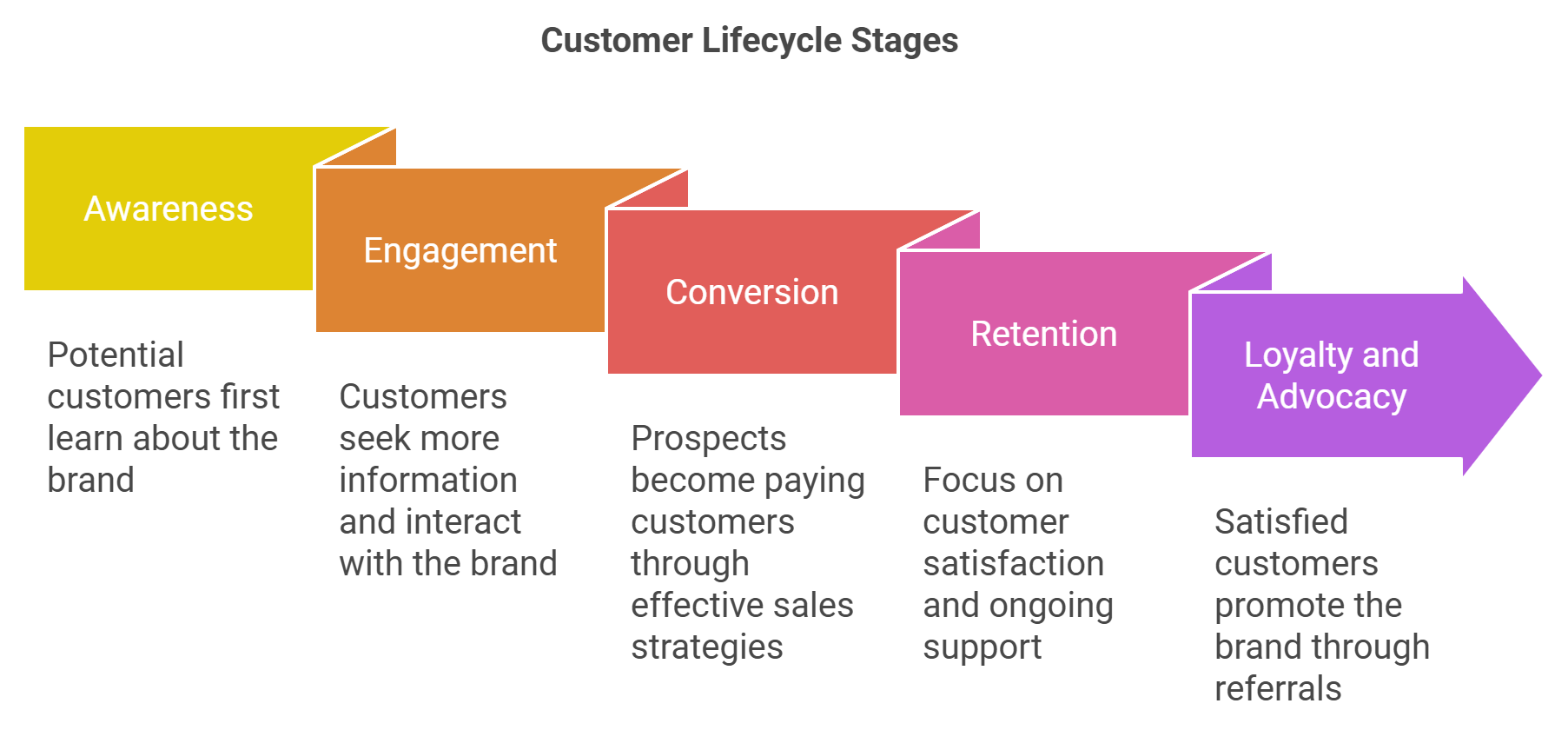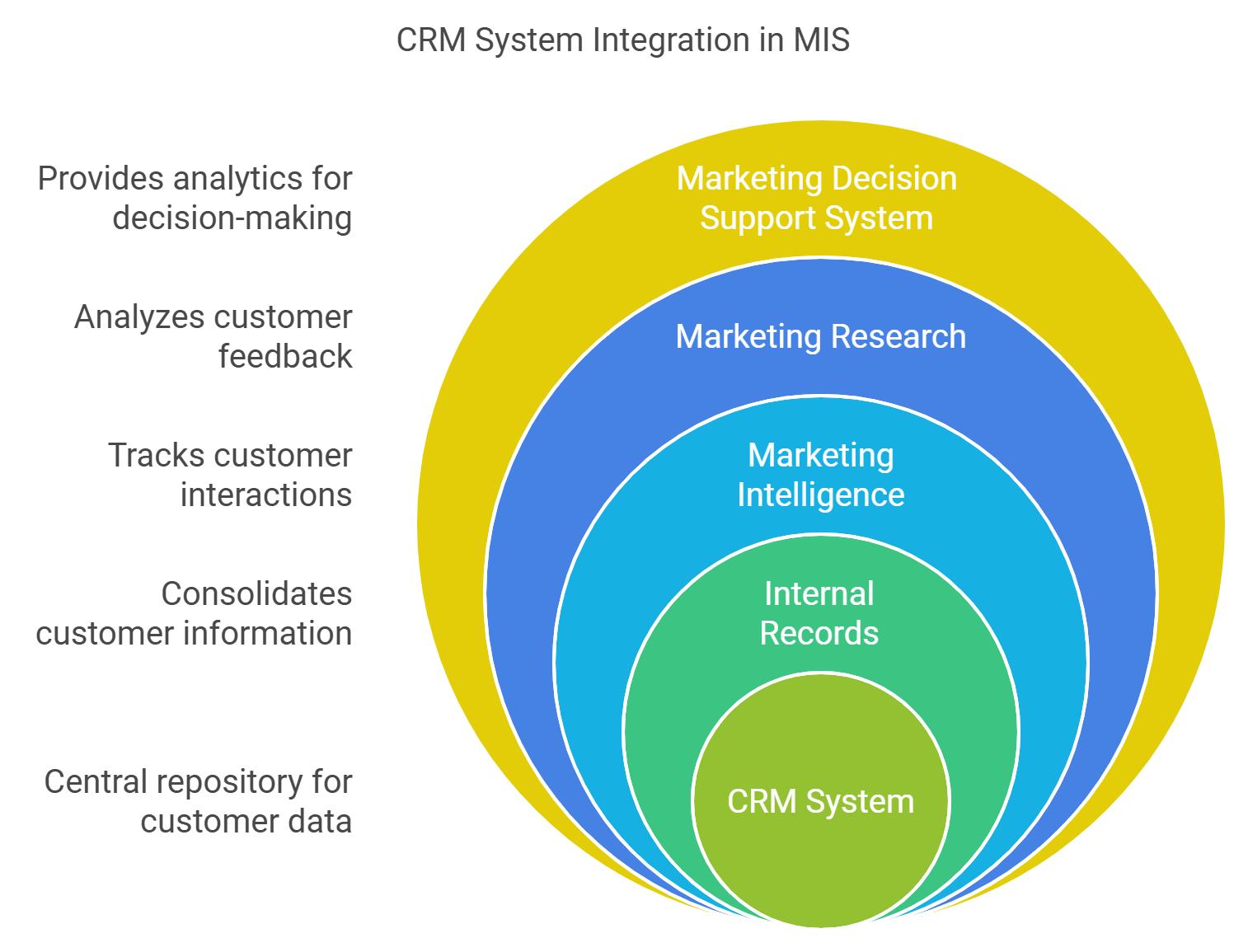Navigating with Data: Marketing Information Systems for Decision-Making
Customer Relationship Management Systems

A customer relationship management (CRM) system is a technology platform designed to help businesses manage and analyze customer interactions and data throughout the customer lifecycle. The primary goal of CRM systems is to enhance customer service relationships, improve customer retention, and drive sales growth.
The Role of CRM in the Customer Lifecycle
The customer lifecycle describes the stages a customer goes through from their initial awareness of a product or service to becoming a loyal advocate. The typical stages in the customer lifecycle include:
- Awareness
- Engagement
- Conversion
- Retention
- Loyalty and advocacy
CRM systems are integral to managing the customer lifecycle effectively. They provide the tools and technology needed to track, analyze, and optimize customer interactions at each stage. The table below shows how CRM systems contribute to each stage.

| Customer Lifecycle | Role of CRM |
|---|---|
| Awareness: This is the stage where potential customers first learn about a company’s products or services. Marketing efforts at this stage focus on building brand recognition and attracting attention through advertising, social media, and other channels.
Engagement: At this stage, potential customers interact with the brand, seeking more information and considering their options. Engagement can occur through website visits, social media interactions, or direct communication with sales representatives. |
CRM systems help segment potential customers and tailor marketing messages to different audience groups, increasing the effectiveness of awareness and engagement efforts. |
| Conversion: This is the point where a prospect becomes a paying customer. Effective sales strategies and a seamless purchasing process are crucial to converting interested prospects into buyers. | By providing sales teams with detailed customer insights and history, CRM systems enable more personalized and effective sales interactions, increasing the likelihood of conversion. |
| Retention: After the initial purchase, the focus shifts to retaining customers by ensuring they are satisfied with their purchase and continue to see value in the product or service. This stage involves providing excellent customer service and ongoing support. | CRM systems track customer interactions and feedback, allowing businesses to address issues promptly and maintain high levels of customer satisfaction. Automated follow-ups and personalized communication help keep customers engaged. |
| Loyalty and Advocacy: In this stage, satisfied customers become loyal advocates, promoting the brand to others through word-of-mouth and referrals. Loyalty programs and personalized communication can help strengthen this relationship. | CRM systems facilitate the creation of loyalty programs and track customer advocacy activities, helping businesses identify and reward their most loyal customers. |
The Role of CRM in Marketing Information Systems
A CRM system fits within a marketing information system (MIS) by interacting with and supporting the four key components of the system.

Here is how a CRM system aligns with the components of an MIS:
Internal Records: A CRM system consolidates customer information and interactions into a single database, making it easier for businesses to access and manage this data. It serves as a central repository for customer-related data, including sales history, contact details, and communication logs. By integrating CRM data with other internal records, businesses can gain a comprehensive view of customer interactions and preferences, enabling more informed decision-making and personalized marketing efforts.
Marketing Intelligence: CRM systems can track customer interactions across various channels — such as email, phone, and social media — providing valuable marketing intelligence. This data helps businesses understand customer behaviour, preferences, and trends. The insights gained from CRM systems contribute to the marketing intelligence component of an MIS, helping businesses stay informed about market dynamics and customer needs.
Marketing Research: CRM systems can facilitate marketing research by collecting and analyzing customer feedback and engagement data. This information helps businesses identify customer needs and preferences, which can inform product development and marketing strategies. By integrating CRM data with marketing research efforts, businesses can enhance their understanding of customer segments and tailor their offerings to meet specific needs.
Marketing Decision Support System (MDSS): CRM systems provide analytics and reporting capabilities that support data-driven decision-making. They offer insights into customer behaviour, sales performance, and marketing campaign effectiveness. The analytical tools within a CRM system contribute to the MDSS component of an MIS, enabling businesses to evaluate different marketing scenarios and optimize their strategies.
Example
Hotel CRM Integration with MIS

Scenario: Hotel Serenity’s CRM Integration with MIS
1. Internal Records: Hotel Serenity uses its CRM system to consolidate guest information into a central database. Each time a guest books a room, their details — such as contact information, room preferences, past stays, and spending habits — are stored in the CRM. For instance, the system records that a frequent guest, Sarah, prefers ocean-view rooms and orders vegetarian meals. By integrating this data with other internal records like billing and housekeeping logs, the hotel ensures seamless operations and personalized service. When Sarah books her next stay, the front desk staff can immediately see her preferences and ensure her room is prepared accordingly.
2. Marketing Intelligence: The CRM tracks customer interactions across multiple channels, including email campaigns, social media engagement, and direct bookings. For example, the system identifies that many guests inquire about spa packages during winter months via social media. This insight becomes part of the hotel’s marketing intelligence, helping the marketing team understand seasonal trends and customer behaviour. Based on this data, Hotel Serenity launches a targeted winter promotion offering discounted spa packages to guests who have shown interest in similar services.
3. Marketing Research: Hotel Serenity uses its CRM to collect customer feedback through post-stay surveys sent via email. The CRM aggregates responses and identifies patterns, such as frequent mentions of slow check-in times in reviews. The marketing research team analyzes this data to understand guest pain points and collaborates with operations to streamline the check-in process. Additionally, the CRM helps segment customers based on their preferences (e.g., business travelers vs. leisure travelers), enabling tailored marketing strategies such as promoting conference facilities to corporate clients.
4. Marketing Decision Support System (MDSS): The CRM provides advanced analytics and reporting tools that support strategic decision-making at Hotel Serenity. For example, the system generates reports showing that guests who book directly through the hotel’s website spend 20% more on additional services like dining and spa treatments compared to those who book through third-party platforms. Armed with this insight, the marketing team decides to invest more in direct booking incentives, such as loyalty program rewards or exclusive discounts for website users.
Summary of CRM’s Role in This Scenario:
- The CRM system acts as the backbone for managing customer data within the hotel’s MIS.
- It supports internal records by centralizing guest information.
- It enhances marketing intelligence by tracking interactions and identifying trends.
- It aids in marketing research by collecting and analyzing feedback.
- It contributes to the MDSS by providing actionable insights for strategic decisions.
This integration ensures that Hotel Serenity delivers personalized experiences while optimizing its marketing strategies for better business outcomes.
Media Attributions
- Figure 1: “Turned-on monitor” by Blake Wisz (2019), via Unsplash, is used under the Unsplash license.
- Figure 2: “Customer lifecycle stages” [created using Napkin.ai] by the author is under a CC BY-NC-SA 4.0 license.
- Figure 3: “CRM system integration with MIS” [created using Napkin.ai] by the author is under a CC BY-NC-SA 4.0 license.
- Figure 4: “Ai Generated Bedroom Bed” by wevfewv (2024), via Pixabay, is used under the Pixabay content license
A system or strategy for managing interactions with current and potential customers, enhancing relationships across the customer lifecycle.

